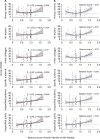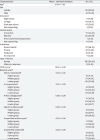1. Lopez AD, Mathers CD, Ezzati M, Jamison DT, Murray CJ. Global and regional burden of disease and risk factors, 2001: systematic analysis of population health data. Lancet. 2006; 367(9524):1747–1757.

2. Rost KM, Meng H, Xu S. Work productivity loss from depression: evidence from an employer survey. BMC Health Serv Res. 2014; 14(1):597.

3. Cole MG, Dendukuri N. Risk factors for depression among elderly community subjects: a systematic review and meta-analysis. Am J Psychiatry. 2003; 160(6):1147–1156.

4. Bonde JP. Psychosocial factors at work and risk of depression: a systematic review of the epidemiological evidence. Occup Environ Med. 2008; 65(7):438–445.

5. Yoon CG, Bae KJ, Kang MY, Yoon JH. Is suicidal ideation linked to working hours and shift work in Korea? J Occup Health. 2015; 57(3):222–229.

6. Yoon JH, Jeung D, Chang SJ. Does high emotional demand with low job control relate to suicidal ideation among service and sales workers in Korea? J Korean Med Sci. 2016; 31(7):1042–1048.

7. Yoon JH, Junger W, Kim BW, Kim YJ, Koh SB. Investigating the time lag effect between economic recession and suicide rates in agriculture, fisheries, and forestry workers in Korea. Saf Health Work. 2012; 3(4):294–297.

8. Yoon JH, Kang MY. The crossover effect of spouses' long working hours on depressive symptoms and suicidal ideation. Ind Health. 2016; 54(5):410–420.

9. Yoon JH, Won JU, Lee W, Jung PK, Roh J. Occupational noise annoyance linked to depressive symptoms and suicidal ideation: a result from nationwide survey of Korea. PLoS One. 2014; 9(8):e105321.

10. Kyaga S, Landén M, Boman M, Hultman CM, Långström N, Lichtenstein P. Mental illness, suicide and creativity: 40-year prospective total population study. J Psychiatr Res. 2013; 47(1):83–90.

11. Stets JE, Burke PJ. Identity theory and social identity theory. Soc Psychol Q. 2000; 63(3):224–237.

12. Takahashi Y, Uchida C, Miyaki K, Sakai M, Shimbo T, Nakayama T. Potential benefits and harms of a peer support social network service on the internet for people with depressive tendencies: qualitative content analysis and social network analysis. J Med Internet Res. 2009; 11(3):e29.

13. Mead GH. The social self. Psychiatry. 1978; 41(2):178–182.

14. Denson TF, Creswell JD, Granville-Smith I. Self-focus and social evaluative threat increase salivary cortisol responses to acute stress in men. J Behav Med. 2012; 35(6):624–633.

15. Gruenewald TL, Kemeny ME, Aziz N, Fahey JL. Acute threat to the social self: shame, social self-esteem, and cortisol activity. Psychosom Med. 2004; 66(6):915–924.

16. Haikal M, Hong RY. The effects of social evaluation and looming threat on self-attentional biases and social anxiety. J Anxiety Disord. 2010; 24(3):345–352.

17. Morris MC, Rao U, Garber J. Cortisol responses to psychosocial stress predict depression trajectories: social-evaluative threat and prior depressive episodes as moderators. J Affect Disord. 2012; 143(1-3):223–230.

18. Radloff LS. The CES-D scale: a self-report depression scale for research in the general population. Appl Psychol Meas. 1977; 1(3):385–401.
19. R Core Team. R: a language and environment for statistical computing. Vienna: R Foundation for Statistical Computing;2013.
20. Redersdorff S, Martinot D. Impact of upward and downward social comparisons on self-esteem: importance of activated identity. Annee Psychol. 2003; 103(3):411–444.
21. Fardouly J, Diedrichs PC, Vartanian LR, Halliwell E. Social comparisons on social media: the impact of Facebook on young women's body image concerns and mood. Body Image. 2015; 13:38–45.

22. Ackermann BJ, Kenny DT, O'Brien I, Driscoll TR. Sound practice-improving occupational health and safety for professional orchestral musicians in Australia. Front Psychol. 2014; 5:973.

23. Manchester RA. Measuring the health of performing artists. Med Probl Perform Art. 2008; 23(3):91–92.

24. Kelman BB. Occupational hazards in female ballet dancers. Advocate for a forgotten population. AAOHN J. 2000; 48(9):430–434.
25. Smith TO, de Medici A, Oduoza U, Hakim A, Paton B, Retter G, et al. National survey to evaluate musuloskeletal health in retired professional ballet dancers in the United Kingdom. Phys Ther Sport. 2017; 23:82–85.

26. Akel S, Duger T. Psychosocial risk factors of musicians in Turkey - use of the job content questionnaire. Med Probl Perform Art. 2007; 22(4):147–152.
27. Vilanova F, Beria FM, Costa AB, Koller SH. Deindividuation: from Le Bon to the social identity model of deindividuation effects. Cogent Psychol. 2017; 4(1):1308104.








 PDF
PDF Citation
Citation Print
Print




 XML Download
XML Download